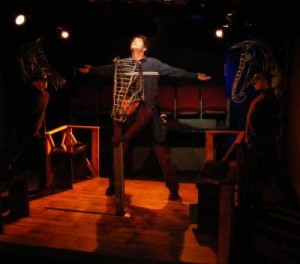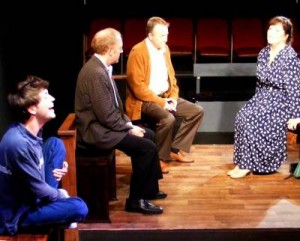
Let’s play a game of word association. I say “Equus” and you say the first thing that pops into your head. Here goes. “Equus.” All right, what was your answer? Was it
a) Horse? b) Richard Burton? c) Psychiatrist? d) Nudity? e) Broadway?
I’d venture to guess that for many if not most theatergoers, the answer is … not a, b, c, or e. After all, when Peter Shaffer’s 1973 drama was revived in London in 2007 and later transferred to Broadway last year, all the tabloids could talk about was Harry Potter naked!
That being said, a theatrical work does not win the Tony for Best Play of the year simply because someone takes his clothes off, and if Shaffer’s mystery drama continues to be staged throughout the world year after year, it is because of its continuing power to fascinate, to move, and to provoke vigorous discussion. Why did 17-year-old Alan Strang blind six horses, this boy who loved (and even worshiped) these animals more than anything else in his life? Why is psychiatrist Martin Dysart so fascinated by Alan’s case that it becomes an obsession, haunting his days and filling his nights with frightening dreams? And what does Dysart mean when he ends the play with these deeply troubled (and troubling) words: “There is now, in my mouth, this sharp chain. And it never comes out.”
You won’t find answers to these questions in this review, and you may not even find them after the post-play discussion that Equus will almost certainly provoke—but what an interesting dialog you will be having with your fellow playgoers, especially after a production as close to perfect as the one now playing at the Chandler Studio Theatre in North Hollywood.
This was my third time seeing Equus on stage, but the first production to truly engross me and indeed keep me on the edge of my seat, as any great suspense drama should. To begin with there is the casting, particularly of the two leads, which could not be better. Add to that August Viverito’s flawless direction and his clever design concept—which makes both the actors and the audience witnesses and jury as the play unfolds—and you have L.A. intimate theater at its very best.
As Dysart, Jim Hanna disappears into a man’s skin about as completely as you’ll ever see an actor do without prosthetic makeup. Stay after the show and you’ll scarcely believe that this jovial American (whom you’ve likely seen in commercial after commercial as the quintessential American Dad) is the same actor who only minutes ago was the deeply troubled, frustrated, disillusioned Londoner whose obsession with a patient’s case comes close to driving him insane. This is rich, nuanced work which I’d venture to guess stands up very well indeed against Anthony Hopkins’ performance in the Broadway original.
Opposite Hanna is a young actor named Patrick Stafford whom you’re likely to be hearing much much more about in months and years to come. Stafford’s rosy-cheeked good looks make his Alan instantly sympathetic, and all the more disturbing, as it’s considerably harder to imagine this angelic-looking young man as a psychologically disturbed criminal than would be the case if, say, a young Sean Penn were playing him. From his first words, “Double your pleasure, double your fun…,” sung, not spoken, to the inane melody of the old Doublemint Gum commercials, Stafford grabs your attention and never lets go. This is beautiful, intense, deeply committed work, and like Hanna’s, a glimpse into a profoundly troubled soul.
Both lead performances could, I believe, get even tough New York critics to sit up and take notice.
Shaffer’s stage directions have the entire cast seated onstage throughout the play, rising to perform their scenes, then returning to their seats to observe the action. Viverito’s ingenious, brilliantly conceived reconfiguration of the matchbox-sized Chandler places several extra rows of seats where the upstage wall would normally be, allowing two-thirds of the audience to face the other third, with half the cast seated in the front row on one side and half on the other. We are they and they are we, both witnessing and judging what is taking place on the raised square stage between us.
The Production Company production reduces the original Broadway cast of fourteen to a more manageable nine (the better to fit into the very intimate Chandler space) and it works. Viverito stages the eye-gouging flashback in such a way that the three actors who play horses are actually portraying two horses each, and each actor doubles as a character normally played by a separate actor. A result of this is that we see the seven cast members who are observing the action, not as the characters they are playing, but as outside observers like us, the only difference being that they assume roles in the play when needed. As a consequence, our own participation in the play is that much greater.
The entire supporting cast give pitch-perfect performances, from Skip Pipo’s gruff atheist father to Karen Furno’s loving but increasingly frustrated mother, and like Hanna and Stafford, the actors who leave the theater after the performance have so vanished into their characters that they are almost unrecognizable as their real selves. Gretchen Koerner does her accustomed fine, incisive work as Hester, the magistrate who sees Dysart’s help as the only way to save Alan. Lauren Schneider gives a lovely performance as Jill, the stable worker whose relationship with Alan proves a catalyst to the troubled boy’s act of violence. John Joyce III, Aaron Misakian, and Michael Rachlis appear as both human and equine characters. (The horses are indeed central “characters” in Alan’s story.) All three (Joyce as the stable owner, Misakian as a young horseman, and Rachlis as a male nurse) do excellent work as humans, but it is their remarkable impersonation of horses that will be remembered long after the final blackout. Their only costuming being the wire-sculpted horse-heads they wear atop their own heads, the three actors (particularly Misakian and Rachlis, who have the bulk of “horse time” on stage) assume head twists and body postures that are uncannily like those of real live horses. Truly amazing work!
A pair of stunningly staged scenes stand out. In the first, Misakian carries Stafford atop his back as the horseman who gives six-year-old Alan his first horseback ride, and the joy in Stafford’s eyes and body language is exquisitely rendered. Later, Stafford once again mounts Misakian, but this time Misakian is Nugget, Alan’s favorite steed, the one he rides secretly at night, and Joyce and Rachlis on opposite sides spin the stage round and round to replicate with great effectiveness the galloping ride Alan is on.
Ric Zimmerman’s excellent lighting design enhances the play’s dramatic moments as does a particularly well-chosen sound and music design. Kelly Graham has served as equestrian consultant, and Armand Desharnais as dialect coach, and aside from an occasional American [æ] that should I think have been a British [ɑ], the accents are spot-on.
Other reviewers will doubtless comment on or explain better than I can Shaffer’s themes, the meaning of Dysart’s dreams, and the significance of Equus’s various metaphors. I’ll stick to a simple bit of advice to anyone looking for fine, provocative theater. See this production of Equus. You won’t find better proof of the quality of Los Angeles’ “under-100-seat” theater scene. With yet another winner on their hands, co-producers Viverito and TL Kolman’s The Production Company is fast on its way to being L.A.’s premiere intimate theater, proving that quality and quantity need not be mutually exclusive.
The Chandler Studio Theatre Center, 12443 Chandler Blvd., North Hollywood.
www.TheProdCo.com
–Steven Stanley
July 3, 2009




 Since 2007, Steven Stanley's StageSceneLA.com has spotlighted the best in Southern California theater via reviews, interviews, and its annual StageSceneLA Scenies.
Since 2007, Steven Stanley's StageSceneLA.com has spotlighted the best in Southern California theater via reviews, interviews, and its annual StageSceneLA Scenies.







 COPYRIGHT 2025 STEVEN STANLEY :: DESIGN BY
COPYRIGHT 2025 STEVEN STANLEY :: DESIGN BY